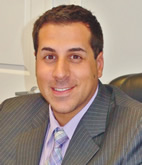Now more than ever, it's important for a land surveyor and lawyer to work as a team. The services of an experienced land surveyor can prevent future expenses or even the undertaking of defending a lawsuit.
Because the main objective of a boundary survey is to determine the location of land ownership lines, the initial phase includes land records research. Research is conducted at local, county and state agencies and offices for the purpose of locating deeds, plans, maps, wills and other documents defining the location and rights associated with a parcel of land. Most of this research is conducted at the county clerk's office, where the current parcel and abutting parcel deeds are traced back in time in order to construct a chain of title. This enables the surveyor to understand the original description of the parcel, as well as determine junior-senior rights associated with adjoining parcels. With the land records research complete, the surveyor can then construct a picture of what the parcel of land should look like according to the language contained in deed descriptions, as well as other documents obtained during the research. This is referred to as the record boundaries of the parcel.
The next phase of the boundary survey involves a thorough field reconnaissance for the purpose of uncovering any boundary evidence, such as iron pipes or rods, monuments, walls, fences, etc. This is a physical investigation of the parcel, and requires a keen knowledge of the types of evidence, land use patterns and local history. Reconnaissance is conducted in light of the record boundaries, and a determined surveyor will hunt tirelessly until the corners of the block or subdivision are found.
A field survey is then conducted to locate the evidence uncovered during the reconnaissance survey. Different methods are employed, including robotic total station traverses (a network of sight lines strategically placed throughout the parcel) and global positioning surveys (GPS). The firm should utilize a full array of conventional and GPS instrumentation, and continually monitor equipment for accuracy and reliability. The methods and type of equipment used depends on factors such as land area, tree cover and required positional tolerances. All survey field measurements should be verified and run through a comprehensive QA/QC procedure, including least squares analysis.
A preliminary plan of the survey can then be drafted using modern CAD software. The next step involves analyzing the relationship of the found, physical evidence with the pre-determined record boundaries. Based on their thorough knowledge of deeds, evidence and boundary retracement principles, land surveyors make determinations on the reliability of existing corners, as well as the replacement of missing corners. A final boundary survey is prepared, displaying the results of the survey, and affixed with a professional land surveyors seal and signature.
A boundary survey is more than just a set of accurate land measurements. Rather, it is a thorough retracing of the title, and analysis of the physical care. It is a land investigation, which defines the location, dimensions and area of a parcel of land, along with all rights the parcel enjoys or to which it is subject.
It's imperative that the surveyor have a thorough understanding of the research, methods, principles and laws relating to land boundary retracement.
Staking a claim is vital to protecting an investment as New York state has a statute of 10 years for adverse possession where a neighbor or adjoining party can claim the land as their own. Noting any encroachments in a timely matter, and correcting any out of possession or adverse possession cases or situations, are vital to protecting property from further land disputes and neighborly issues that may damage the property or its enjoyment or one's transfer of property. Many property owners erroneously believe that the fence is the property line. This is not true and only a licensed land surveyor can delineate and monument a boundary line which is an imaginary line. It is very important to have a reputable licensed land surveyor stake out or monument boundaries when laying out fences, hedges, curbs or any other structures that might be a possible encroachment and further damage the title or property ownership.
Frank S. Ferrantello, PLS, is a New York State Licensed Land Surveyor with over 20 years of experience in Surveying, Civil Engineering, and Land Use Planning. Both his field and office Work experience have dealt with a wide range of projects and sites including residential single, multifamily, high rise municipal, utility, private and public, commercial, and industrial. Prior to and post college, Mr. Ferrantello worked for the firm of John P. Ferrantello PC from 1998 to 2010 and MJM engineering from 2008 to 2016. His duties consisted of performing office and field surveying, drafting, research, computations, boundary analysis, solutions, investigations and determinations.
©Copyright - All Rights Reserved
DO NOT REPRODUCE WITHOUT WRITTEN PERMISSION BY AUTHOR.









